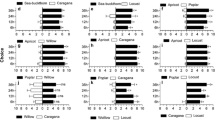Summary
|
-
1.
To determine the effect of plant structure on the searching efficiency of Coccinella septempunctata L. larvae, their functional response on pea and bean plants was compared.
-
2.
The attack coefficient a was lower on pea than on bean plants.
-
3.
This was not due to a difference in the coincidence of prey distribution and predator searching effort, but was due to larvae falling off the smooth leaves of pea plants significantly more frequently than off bean plants.
-
4.
It was concluded that plant structure is an important factor in determining the quality of a habitat for coccinellids.
Similar content being viewed by others
References
Arzet R (1973) Suchverhalten der Larven von Chrysopa carnea Steph. (Neuroptera: Chrysopidae). Z Angew Entomologie 74:64–79
Banks CJ (1957) The behaviour of individual coccinellid larvae on plants. Animal Behaviour 5:12–24
Boldyrev MJ, Wilde WHA (1969) Food seeking and survival in predaceous coccinellid larvae. Can Entomologist 101:1218–1222
Carter MC (1982) The foraging strategy of Coccinella septempunctata L. Unpublished PhD. Thesis, University, of East Anglia
Carter MC, Dixon AFG (1982) Habitat quality and the foraging behaviour of coccinellid larvae. J Animal Ecology 51:865–878
Charnov EL (1976) Optimal foraging: the marginal value theorem. Theoretical Population Biology 9:126–136
Cook RM, Cockrell BJ (1978) Predator ingestion rate and its bearing on feeding time and the theory of optimal diets. J Animal Ecology 47:529–549
Dixon AFG (1959) An experimental study of the searching behaviour of the predatory coccinellid beetle, Adalia decempunctata (L.). J Animal Ecology 28:259–281
Dixon AFG (1970) Factors limiting the effectiveness of the coccinellid beetle, Adalia bipunctata (L.) as a predator of the sycamore aphid, Drepanosiphum platanoides (Schr.). J Animal Ecology 39:739–751
Dixon AFG, Russell RJ (1972) The effectiveness of Anthocoris nemorum and A. confusus (Hemiptera: Anthocoridae) as predators of the sycamore aphid, Drepanosiphum platanoides. II Searching behaviour and the incidence of predation in the field. Entomol Exp Applicata 15:35–50
Evans HF (1976a) The searching behaviour of Anthocoris confusus (Reuter) in relation to prey density and plant surface topography. Ecol Entomol 1:163–169
Evans HF (1976b) The effect of prey density and host plant characteristics on oviposition and fertility in Anthocoris confusus (Reuter). Ecol Entomol 1:157–161
Fleschner CA (1950) Studies on searching capacity of the larvae of three predators of the citrus red mite. Hilgardia 20:233–265
Gurney B, Hussey NW (1970) Evaluation of some coccinellid species for the biological control of aphids in protected crop**. Ann Appl Biol 65:451–458
Hildrew AG, Townsend CR (1977) The influence of substrate on the functional, response of Plectrocnemia conspersa (Curtis) larvae (Trichoptera: Polycentropodidae). Oecologia (Berl) 31:21–26
Hubbard SF, Cook RM (1978) Optimal foraging by parasitoid wasps. J Animal Ecology 47:593–604
Kesten U (1969) Zur Morphologie und Biologie von Anatis ocellata (L.) (Coleoptera: Coccinellidae). Z Angew Entomologie 63:412–445
Marks RJ (1977) Laboratory studies of plant searching by Coccinella septempunctata L. larvae. Bull Entomol Res 67:235–241
Putman WL (1964) Occurrence and food of some coccinellids (Coleoptera) in Ontario peach orchards. Can Entomologist 96:1149–1155
Pyke GH, Pulliam HR, Charnov EL (1977) Optimal foraging: a selective review of theory and tests. Q Rev Biol 52:137–154
rogers DJ (1972) Random search and insect population models. J Animal Ecology 41:369–383
Scopes NEA (1969) The potential of Chrysopa carnea as a biological control agent of Myzus persicae on glasshouse chrysanthemums. Ann Appl Biol 64:433–439
Townsend CR, Hughes RN (1981) Maximising net energy returns from foraging. In: Townsend CR and Calow P (eds) Physiological Ecology, an evolutionary approach to resource use. Blackwell Scientific Publications, Oxford, pp 86–108
Wratten SD (1973) The effectiveness of the coccinellid beetle, Adalia bipunctata (L.), as a predator of the lime aphid, Eucallipterus tiliae L. J Animal Ecology 42:785–802
Author information
Authors and Affiliations
Rights and permissions
About this article
Cite this article
Carter, M.C., Sutherland, D. & Dixon, A.F.G. Plant structure and the searching efficiency of coccinellid larvae. Oecologia 63, 394–397 (1984). https://doi.org/10.1007/BF00390671
Received:
Issue Date:
DOI: https://doi.org/10.1007/BF00390671




